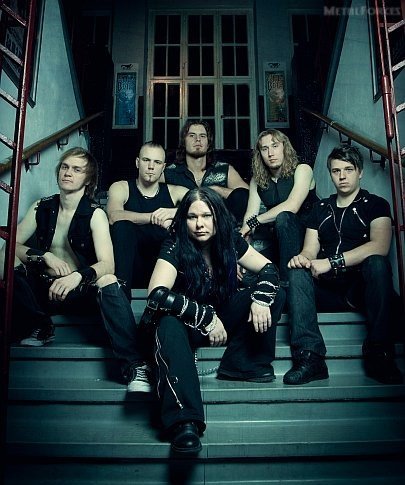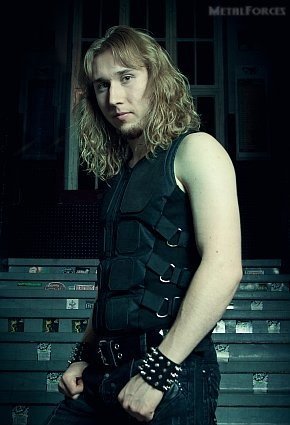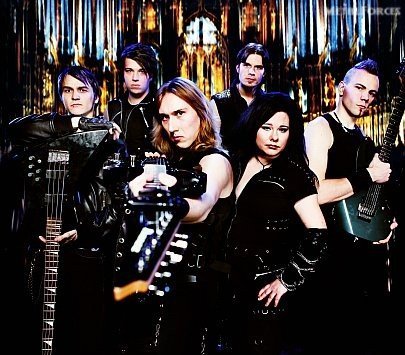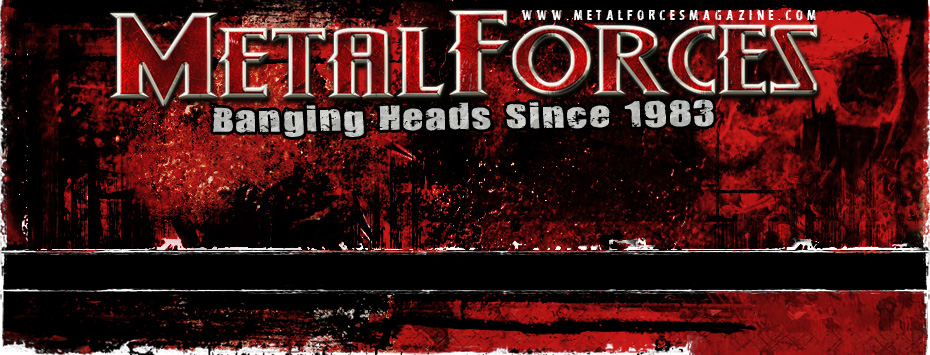
BATTLE BEAST – Die-Hard Warriors
Anthony Morgan
January 2012

|
Hailing from Helsinki, Finland, Battle Beast consist of guitarist and vocalist Anton Kabanen, vocalist Nitte Valo, guitarist Juuso Soinio, bassist and backing vocalist Eero Sipilä, keyboardist and backing vocalist Janne Björkroth, and drummer Pyry Vikki. 2008 was the year of their formation, Anton having met Pyry in high school with Juuso being Anton’s friend from earlier days. In high school, the trio initially performed together. “It’s actually been a pretty long existence for this band,” notes Anton. “Many think that it’s only been three years, but it was actually my dream to form a band when I was maybe ten years old or something. In 2008 after high school, the army, and all that stuff, Pyry, Juuso and I found Nitte, and Eero. Janne then came along in 2009 after a few keyboardist changes.”
Battle Beast’s name spontaneously emerged. “I don’t remember exactly how the name came about, but I just made it up from two different elements that I like,” the axeman remembers. “It’s a pretty effective name, and represents what we play. I don’t know if you’re familiar with the fact that Battle Beasts are toy figures, and it was some kind of cartoon show in the late 80s or something. We didn’t know until I came up with the name though, so only after that did we find out about these toy figures. It’s quite funny, but it has nothing to do with the band name actually. Many people have asked if our name has some connection with those toy figures.”
The collective began to play live performances in 2009. “That was really the beginning,” Anton reckons. “We recorded some demos, all the basic stuff that every band actually does in the beginning. We tried to play at every place we could, and contacted all the labels in the world and in Finland. We sent our demos everywhere and waited for an answer, but no-one actually answered us – almost no-one. Anyway, we just kept on playing gigs and sending demos.”
Alongside Merging Flare, Battle Beast supported Blaze Bayley in May 2010 for four Finnish gigs. “That was the first big thing that happened,” the singer feels. “It was really cool supporting Blaze Bayley. Blaze Bayley was a really nice guy, and all the other guys in the band too. It was a really good experience for us; he’s really well known and he’s done all these things, so it was an honour for us to be a part of that. We enjoyed it very much and we learnt a lot of things about how to be as a band, because it was the first time we really played a few shows in a row. Normally we’ve only played one show, and then played another show maybe after two months, one month, or something like that. We played those shows, and after that we participated in the semi-finals of Wacken’s Metal Battle. That was the national version.”
At August 2010’s Wacken Open Air in Germany, the outfit contended with 26 other outfits as a part of the international Metal Battle competition and emerged victorious. “The funny thing is that Finland actually has always been pretty late in organising the national version of Metal Battle, so we knew that we had to go Wacken only two to three days before the festival was about to begin,” Anton recalls. “It was like hell to get those plane tickets. When we got there we realised that half of our luggage was lost by the flight company. We then played the show there at Metal Battle, and we really didn’t have any expectations. To us it was just a gig, but a really good gig at a big event. It was great. The audience enjoy themselves, and when they see a band they scream and put their fists in the air. It was a great feeling because it doesn’t happen always – sometimes it’s hard to win the audience on your side. When you play at clubs people are maybe afraid or embarrassed to shout out and raise their fists in the air, but at Wacken it’s a totally different feeling. There’s only metalheads, and they’re screaming out, partying, and having a good time.
“We didn’t see it as a competition though, and we had to leave to go back to Finland before the announcement of the Metal Battle winner. We only got to know about the victory one week after the festival, and everyone at the festival during the winners’ announcement were wondering where we were. No-one knew that we had already gone back to Finland, but then we realised in Finland. We checked our MySpace page, and the song listens suddenly skyrocketed; there were maybe 800 to 900 song listens per day, which is really a big amount. Normally there were maybe 30 to 50 song listens per day, but after Metal Battle there were much more. It was a great experience, and we got a lot of attention in the metal scene. In Finland we also got to do some small interviews, so it was a really good thing.”

|
That same month Battle Beast won the title of ‘Radio Rock Star 2010’, the competition being organised by Finnish rock radio channel Radio Rock. This would culminate in the issue of inaugural single ‘Show Me How To Die’, released through Hype Records on January 17th, 2011. “We had to pick our first single for radio play which was ‘Show Me How To Die’, because we won that competition that was organised by Radio Rock,” the mainman explains. “We then recorded the rest of the songs for the album. For us, it was once again – like the Blaze Bayley tour – a new thing for us because we had never been to the studio. ‘Show Me How To Die’ is about the beast’s need to get out of that planet. He’s immortal and he’s trapped in that planet, and the only way he can get out is to die and be reborn on a new planet. He needs to die so he can be reborn somewhere else but that doesn’t happen, at least not on this album. Even though he will die, he will always be reborn. That song is really agonising, where he wants to get out to a better world. Not to die though, so it’s not about suicide. It’s a song about someone wanting a better life.”
Steel underwent issue on April 13th, 2011 in Finland. “We had recorded our demos by ourselves in the rehearsal space where we play, so in the studio we were learning new things,” Anton reveals “Recording started on the last day of November 2010 or something like that, and we didn’t record for all that time – there were breaks. We recorded in December for maybe one week or something like that, and then we had a few weeks break. We then continued in January, and so on. All in all it took about 20 days to make the record; to record, mix, and master it all took about 20 days. It was finished maybe in February 2011 if I remember correctly, and it was released in April 2011. The feedback’s been mostly good, so in only three years we’ve already done our first record and all these good things have happened to us.”
Hype Records oversaw the album’s release in Finland and Sweden. “It’s a small Finnish label,” the co-founder explains. “They’ve done this license deal with Nuclear Blast for us, so basically we have two labels that we are working with. Hype Records is the first label we signed with though. It’s a small Finnish label that mainly does releases here in Finland, but also does license deals whenever possible for their bands. Nuclear Blast actually contacted Hype Records and then Hype Records told us, so that’s how the co-operation began. We’re really glad that they finally showed their interest in us, because – like I said – in the early days we had sent many demos all around the world. We sent demos to Nuclear Blast so many times, but finally when we didn’t actually expect anything suddenly they contacted Hype Records and showed their interest in us. So, here we are now.”
Sonic Pump Studios in Helsinki acted as a recording location for Steel, with Thunderstone frontman Nino Laurenne handling production duties. “He designed the soundscape of that album,” Anton surmises. “I was more the songwriter who was telling the players ‘Lay it down like this,’ ‘Sing like that,’ and ‘Let’s do this here.’ Nino gave me free hands; they were my compositions, and he trusted me. Maybe in pop music or something producers pretty much tell musicians ‘Play like this,’ ‘Sing like that,’ and ‘Let’s do a harmony here’ and things like that, but Nino didn’t do that because he trusted that I knew what I wanted to record. It was good to have free hands, but the bad thing is that even though we were there 20 days we still ended up being in quite a hurry towards the end.
“I would have liked to have stayed a little bit longer to finish all those things, but I think that’s quite normal for every artist because no-one is ever completely satisfied with their work. I don’t want to sound like I’m saying there are bad mistakes on that album, but there are some vocal lines and stuff that could have been sung better, some guitar solos could have been better, and stuff like that. Every musician is always striving though, because it’s hard to impress yourself. I don’t know how people would have reacted if we recorded some parts differently, but it’s a personal fight actually. It’s not there just to please the fans, because we also like to please ourselves when recording.”
The guitarist tends to author each composition at home alone. “When the song is finished I present it to the band and we start to play it and rehearse it, and that’s about it basically,” he tells. “We don’t write together that much, but in the studio for instance our keyboardist Janne sometimes has good ideas. We then try out those ideas, and if they are better than the original ones we use those better ones. Usually I try to make songs at home alone.”
Anton deems Battle Beast’s musical style to be “straightforward heavy metal. I think that’s the simplest way because there aren’t as many of these kinds of bands out there; most metal bands play technically difficult songs, and they don’t tend to play simple music like we do. I personally think that our album is one of the most simple metal albums out there. It’s rare nowadays to find a metal album that is really simple and enjoyable, and easy to listen to in the catchy way. These are songs that are easy to remember; there aren’t too many elements, and the song structures aren’t so difficult. There aren’t too many parts in our songs. There’s usually maybe three to four parts but to me there’s actually only good and bad music in the end, even though I consider myself a heavy metal purist. I mean, I love bands like Judas Priest, and Manowar, and W.A.S.P., and Black Sabbath, and those bands. I think that if some metal bands have the same elements as a pop band though, it doesn’t mean that they are pop. It’s only music in the end, and what sounds good should be used. You shouldn’t avoid some good-sounding things only because some other genre uses those things. They’re pretty simple, and that’s actually the power behind Battle Beast.”

|
Classic metal influences aren’t the group’s sole musical influences, however. “Actually, those bands that I just mentioned – Judas Priest, Manowar, W.A.S.P., and Black Sabbath – they’re my personal favourite bands, but each member has their own favourites,” the vocalist reminds. “Of course – like I said – there’s only good and bad music. Any time I hear good music, it influences me. I remember those good things that I hear, and they’re always in the back of my head and stay there. Not just these bands influence me, but they’re my favourites.”
Modern influences inform Battle Beast’s sound as well, somewhat. “If I watch a modern movie and I hear a cool soundtrack or something like that, then in that way there are modern influences,” Anton speculates. “I try not to think of what is modern or what is old though. To me music is always timeless, and I don’t care where it comes from. I know the origins of this kind of metal and we can’t deny that we’re influenced by old bands, but there are also modern elements in our music.”
Much of Steel’s lyrics concern an immortal warrior and his adventures in a world ruled by machines. “The beast on the CD cover is the main protagonist,” the axeman discloses. “He’s in this world dominated by machines, and in that world he’s seeking a mysterious woman. He’s really obsessed with that woman because she knows some answers to his questions, and while he’s looking for her in that world he’s also fighting those machines and protecting a few survivors on that planet – the survivors are a part of armageddon’s clan. ‘Enter The Metal World’ tells the story of how that beast got to that world, and then the song ‘Armageddon Clan’ is a song about those few survivors on that planet. It’s really influenced pretty much by all kinds of science fiction and cyberpunk movies; I’m a big fan of The Terminator movie (1984), and I like the book Neuromancer (1984) by William Gibson. So yeah, that’s about it. That’s the main story on the album.”
Title cut ‘Steel’ relates to this central tale. “Many people think that Battle Beast is just about ‘Metal this,’ ‘Metal that,’ ‘Steel this’ and so forth, but actually when that song mentions the words ‘Metal’ and ‘Steel’ it’s all related to artificial intelligence that are taking over,” Anton insists. “That’s why in that verse you can see that the machines wanna dominate completely, and that’s why they check around the world. They wanna have full power, and destroy every living thing.”
Not all of Steel’s compositions are connected to this main story, though. “There are two tracks that are related to Berserk by the artist Kentaro Miura,” the singer divulges. “I’m a big fan of his work, and those songs are ‘Victory’ and ‘The Band Of The Hawk’. Then there’s ‘Savage And Saint’, ‘Justice And Metal’, and ‘Iron Hand’, which are all individual songs unrelated to either of those stories. The first verse in ‘Justice And Metal’ is about Joey DeMaio of Manowar to be honest, and in the second verse we mention ‘Metal gods’ and by that we’re referring to Judas Priest. In general the song is just about heavy metal. That’s actually the only song where we sing about heavy metal music, but with all those other songs they’re not about heavy metal music but the machines and that kind of stuff. That’s the only song, which is kind of a heavy metal party song. ‘Savage And Saint’ is about my personal thoughts, and my own life experiences. ‘Iron Hand’ is actually kind of related to my own story about those machines though, and Berserk as well. It’s a mixture of stories in ‘Iron Hand’.”
Plans for a sophomore album are underway, a 2013 issue roughly pencilled in. “We’ve been doing some pre-production for some time, and we’re about to record drums in March I think,” Anton announces. “We’ll try to record the whole album in the summer, if possible. The songs are already written. We’re only waiting for the opportunity to record those songs, and the next album will be produced by me or by the band together. We want it to be less stressful. Like I told you before, we would have stayed a bit longer in the studio, and for the second album we wanna have more of this relaxed feeling. We wanna feel that there’s no hurry, that we can record whenever possible, whenever we want. We can then get the best result out of ourselves.”
Steel was released in Finland on April 13th, 2011 through Hype Music, and subsequently in the rest of the world on January 27th, 2012 via Nuclear Blast Records.
Interview published in January 2012.
Related Posts via Categories
- SCOTTISH SICKNESS – A Report On The Scottish Death Metal Scene, Featuring BRAINBATH, PUTRID FATE And RANCID CADAVER (October 2022) | Features / Interviews @ Metal Forces
- LARVAE – Join The Hardcore Cult! (June 2022) | Features / Interviews @ Metal Forces Magazine
- TRENCH FOOT – Sacrificing Morals For Gory Obscenities (June 2022) | Features / Interviews @ Metal Forces Magazine
- L.A. GUNS – Trigger Happy (March 2019) | Features / Interviews @ Metal Forces Magazine
- CANCER – Crimes So Evil (November 2018) | Features / Interviews @ Metal Forces Magazine
- U.D.O. – The Tank Drives On (August 2018) | Features / Interviews @ Metal Forces Magazine
- SIEGE OF POWER – Bleeding For The Cause (August 2018) | Features / Interviews @ Metal Forces Magazine
- MOONSPELL – A Taste Of Live Eternity (August 2018) | Features / Interviews @ Metal Forces Magazine
- MONSTROSITY – Dark Matter Invocation (August 2018) | Features / Interviews @ Metal Forces Magazine
- SATAN – Five Magicians (August 2018) | Features / Interviews @ Metal Forces Magazine
|
|





